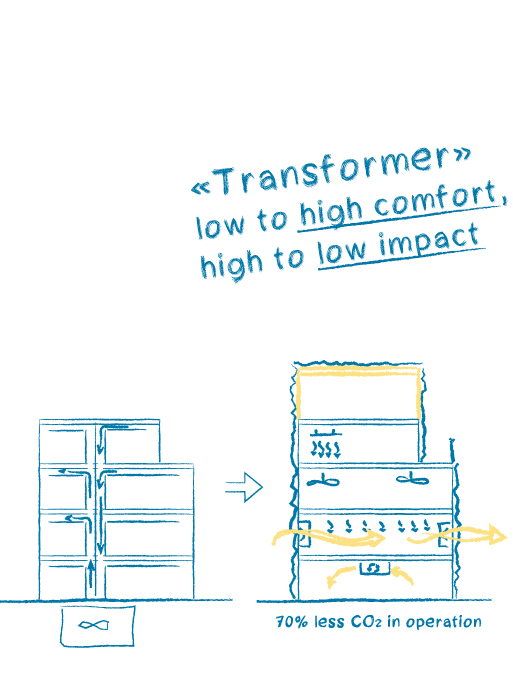Energy Retrofit and Modernization of Rathausstraße 15, Rosenheim, Germany


The five-story office building from the 1970s is in the city center in Rosenheim. The building’s envelope does not meet current energy standards, and its spatial and technical equipment are outdated. The original structure will be preserved, but more stories will be added. The goal of the project is to achieve a “Passive House Plus” standard, with an annual primary energy demand of only 40% of the legal standard. Preserving the “gray energy” in the existing building stock, combined with the wooden construction of the building envelope, saves over 1,000 tons of CO₂ compared to demolition and conventional new construction, and 4,600 tons of waste.
The narrow building allows for effective natural cross-ventilation. Daylight can be optimally utilized in nearly all rooms. The reinforced concrete structural framework plays a central role in the passive cooling concept. The thermal mass of the concrete ceilings can balance temperature fluctuations if not suspended. Especially in summer, they serve as heat buffers: cooled overnight, they absorb heat slowly during the day, maintaining a comfortable indoor climate. This requires continuous natural ventilation at night to expel the heat accumulated during the day, enabling the building to cool passively and energy-efficiently.
On hot days, ceiling fans create air movement, making the temperature feel approximately 2 °C cooler even without active cooling systems. Giving individual users control over their indoor environment enhances workplace satisfaction by allowing them to tailor the climate to their preferences. Natural ventilation further supports comfort through operable, weather-resistant, and sound-insulating elements that enable personal access to fresh air – even in noisy, urban settings.
A demand-controlled mechanical background ventilation system ensures consistently high indoor air quality even during the cold season. Efficient heat recovery reduces heating energy needs in winter. Ventilation units on each floor distribute preheated fresh air into the occupied areas and passively extract exhaust air back into the circulation zones. This design minimizes the number of fresh air ducts and fire protection dampers.
Active radiant panels heat the rooms efficiently, precisely, and quickly. They provide high thermal comfort and contribute to room acoustics by creating sound-absorbing surfaces. They can also be used for active cooling if needed during increasingly frequent summer heatwaves.
The roof addition will be constructed as a timber structure with clay ceilings. Wood has a low ecological footprint and stores CO₂. Clay is non-toxic, absorbs air pollutants, provides thermal stability, and naturally regulates indoor humidity.
The concept aims for robust building operation, and thanks to its simple, easy-to-use, and low-maintenance technology, costs remain low. This approach – combining resource-efficient heritage preservation with the building’s passive qualities in daylight, thermal insulation, and natural ventilation – is pioneering and serves as a model for future renovation projects.



